Zara's Marketing Plan: Strategies, Barriers, and Ethical Issues
VerifiedAdded on 2019/12/03
|28
|6276
|147
Report
AI Summary
This report provides a comprehensive analysis of Zara's marketing plan, examining various aspects such as its organizational capabilities, including tangible and non-tangible resources, and core competencies through the VIRO model. It delves into Zara's marketing planning activities, evaluating its changing perspectives over time, from production to social marketing. The report also explores Zara's new product development process, including idea generation, screening, concept development, and product launching, while analyzing the role of the Boston Consulting Group Matrix. Furthermore, it outlines Zara's marketing plan, focusing on the four Ps (Product, Price, Promotion, and Place), and addresses barriers to marketing plans, ethical issues, and recommendations for improvement. The report offers insights into pricing, distribution, and communication mix strategies, along with factors affecting the marketing plan and techniques for auditing. Finally, it emphasizes the importance of marketing planning in the strategic planning process, providing a holistic view of Zara's marketing endeavors.

Marketing Planning
Paraphrase This Document
Need a fresh take? Get an instant paraphrase of this document with our AI Paraphraser
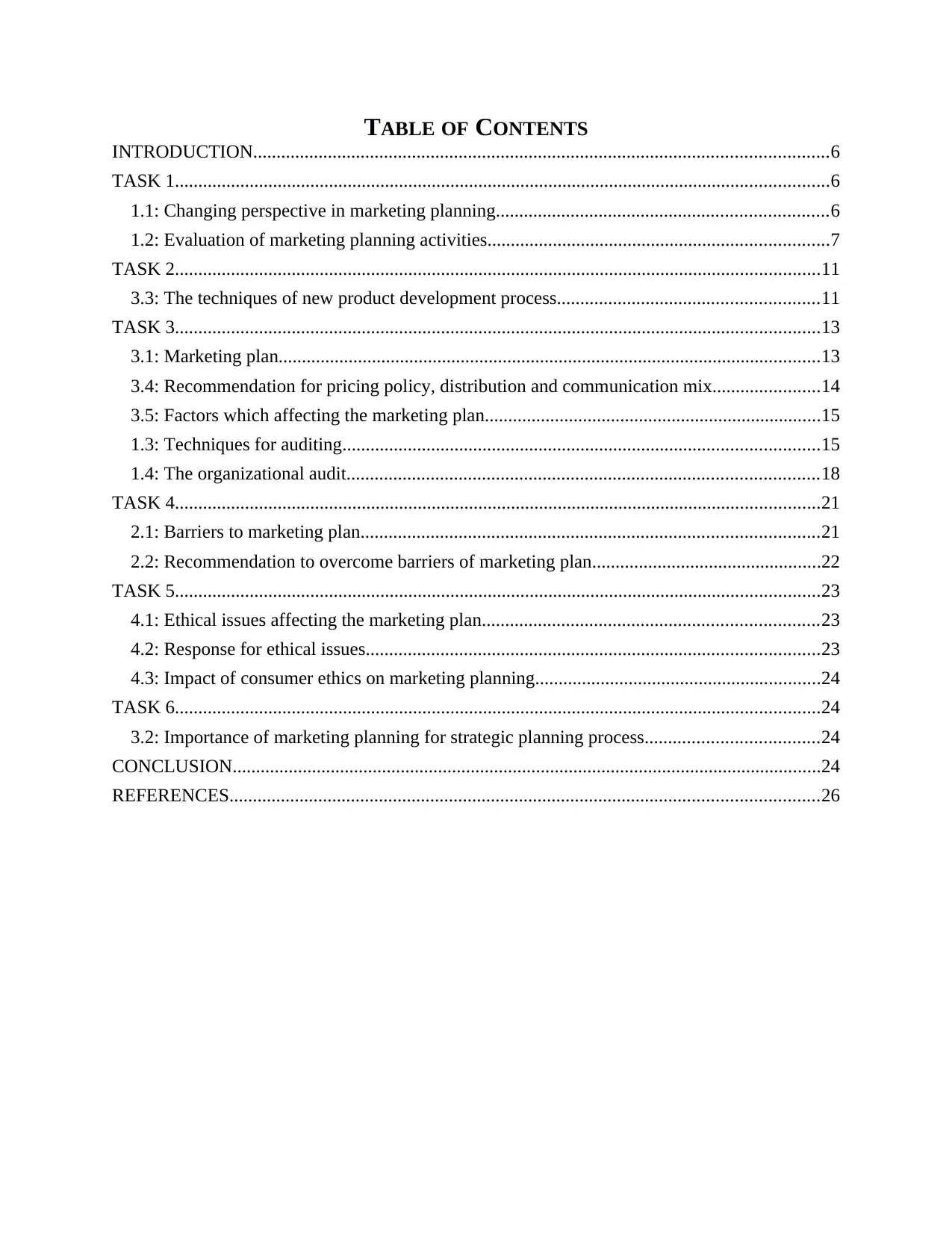
TABLE OF CONTENTS
INTRODUCTION...........................................................................................................................6
TASK 1............................................................................................................................................6
1.1: Changing perspective in marketing planning.......................................................................6
1.2: Evaluation of marketing planning activities.........................................................................7
TASK 2..........................................................................................................................................11
3.3: The techniques of new product development process........................................................11
TASK 3..........................................................................................................................................13
3.1: Marketing plan....................................................................................................................13
3.4: Recommendation for pricing policy, distribution and communication mix.......................14
3.5: Factors which affecting the marketing plan........................................................................15
1.3: Techniques for auditing......................................................................................................15
1.4: The organizational audit.....................................................................................................18
TASK 4..........................................................................................................................................21
2.1: Barriers to marketing plan..................................................................................................21
2.2: Recommendation to overcome barriers of marketing plan.................................................22
TASK 5..........................................................................................................................................23
4.1: Ethical issues affecting the marketing plan........................................................................23
4.2: Response for ethical issues.................................................................................................23
4.3: Impact of consumer ethics on marketing planning.............................................................24
TASK 6..........................................................................................................................................24
3.2: Importance of marketing planning for strategic planning process.....................................24
CONCLUSION..............................................................................................................................24
REFERENCES..............................................................................................................................26
INTRODUCTION...........................................................................................................................6
TASK 1............................................................................................................................................6
1.1: Changing perspective in marketing planning.......................................................................6
1.2: Evaluation of marketing planning activities.........................................................................7
TASK 2..........................................................................................................................................11
3.3: The techniques of new product development process........................................................11
TASK 3..........................................................................................................................................13
3.1: Marketing plan....................................................................................................................13
3.4: Recommendation for pricing policy, distribution and communication mix.......................14
3.5: Factors which affecting the marketing plan........................................................................15
1.3: Techniques for auditing......................................................................................................15
1.4: The organizational audit.....................................................................................................18
TASK 4..........................................................................................................................................21
2.1: Barriers to marketing plan..................................................................................................21
2.2: Recommendation to overcome barriers of marketing plan.................................................22
TASK 5..........................................................................................................................................23
4.1: Ethical issues affecting the marketing plan........................................................................23
4.2: Response for ethical issues.................................................................................................23
4.3: Impact of consumer ethics on marketing planning.............................................................24
TASK 6..........................................................................................................................................24
3.2: Importance of marketing planning for strategic planning process.....................................24
CONCLUSION..............................................................................................................................24
REFERENCES..............................................................................................................................26
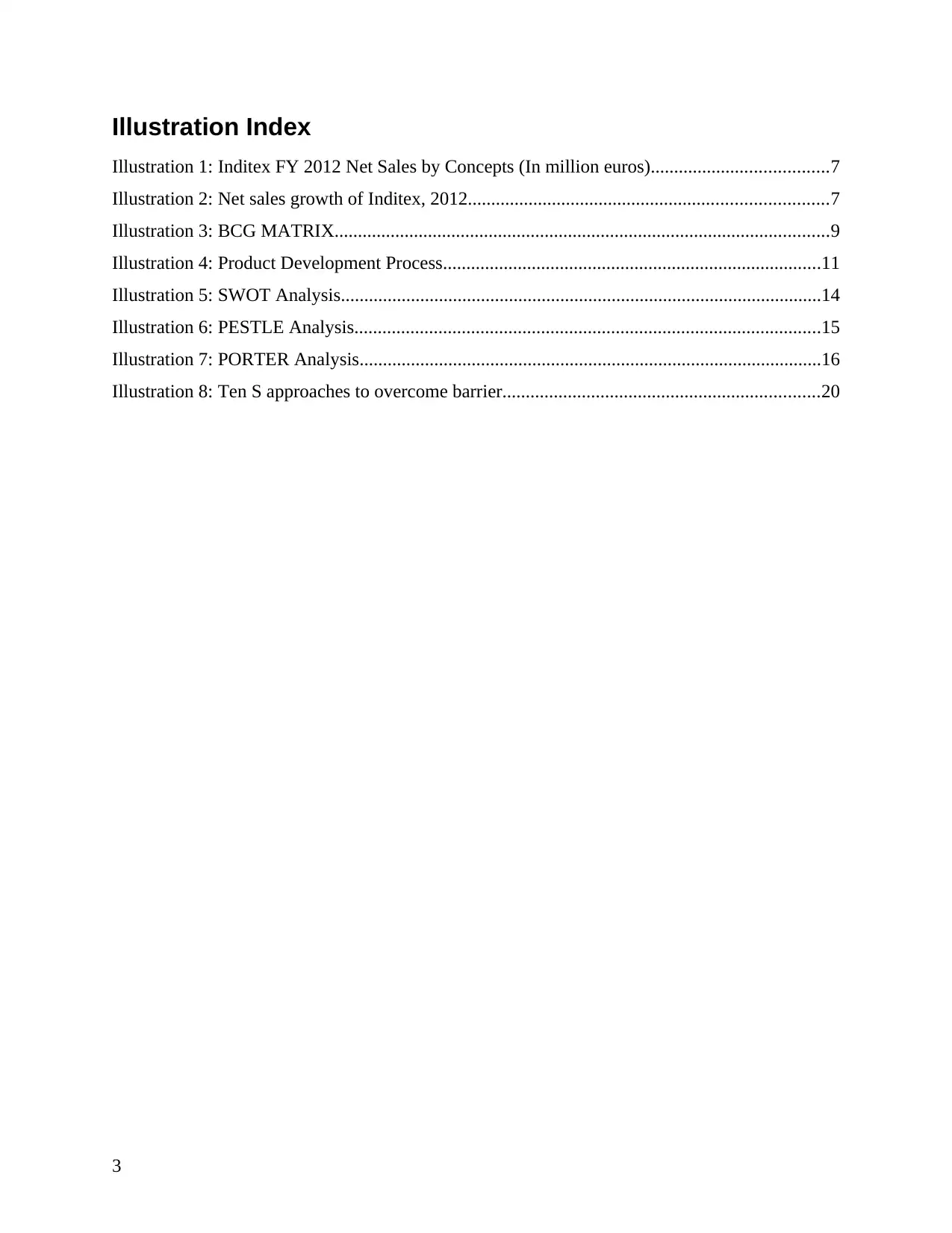
Illustration Index
Illustration 1: Inditex FY 2012 Net Sales by Concepts (In million euros)......................................7
Illustration 2: Net sales growth of Inditex, 2012.............................................................................7
Illustration 3: BCG MATRIX..........................................................................................................9
Illustration 4: Product Development Process.................................................................................11
Illustration 5: SWOT Analysis.......................................................................................................14
Illustration 6: PESTLE Analysis....................................................................................................15
Illustration 7: PORTER Analysis...................................................................................................16
Illustration 8: Ten S approaches to overcome barrier....................................................................20
3
Illustration 1: Inditex FY 2012 Net Sales by Concepts (In million euros)......................................7
Illustration 2: Net sales growth of Inditex, 2012.............................................................................7
Illustration 3: BCG MATRIX..........................................................................................................9
Illustration 4: Product Development Process.................................................................................11
Illustration 5: SWOT Analysis.......................................................................................................14
Illustration 6: PESTLE Analysis....................................................................................................15
Illustration 7: PORTER Analysis...................................................................................................16
Illustration 8: Ten S approaches to overcome barrier....................................................................20
3
⊘ This is a preview!⊘
Do you want full access?
Subscribe today to unlock all pages.

Trusted by 1+ million students worldwide
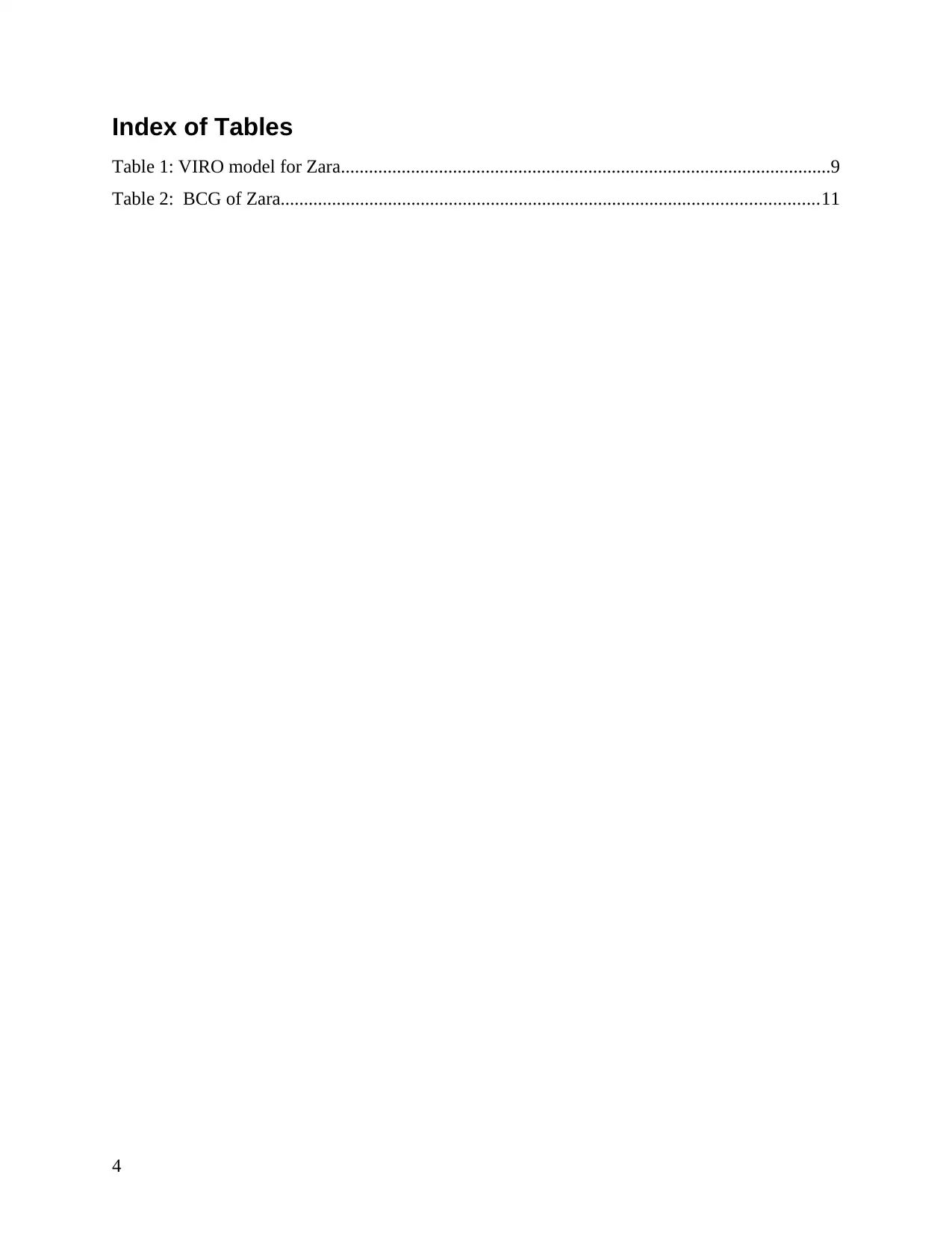
Index of Tables
Table 1: VIRO model for Zara.........................................................................................................9
Table 2: BCG of Zara...................................................................................................................11
4
Table 1: VIRO model for Zara.........................................................................................................9
Table 2: BCG of Zara...................................................................................................................11
4
Paraphrase This Document
Need a fresh take? Get an instant paraphrase of this document with our AI Paraphraser
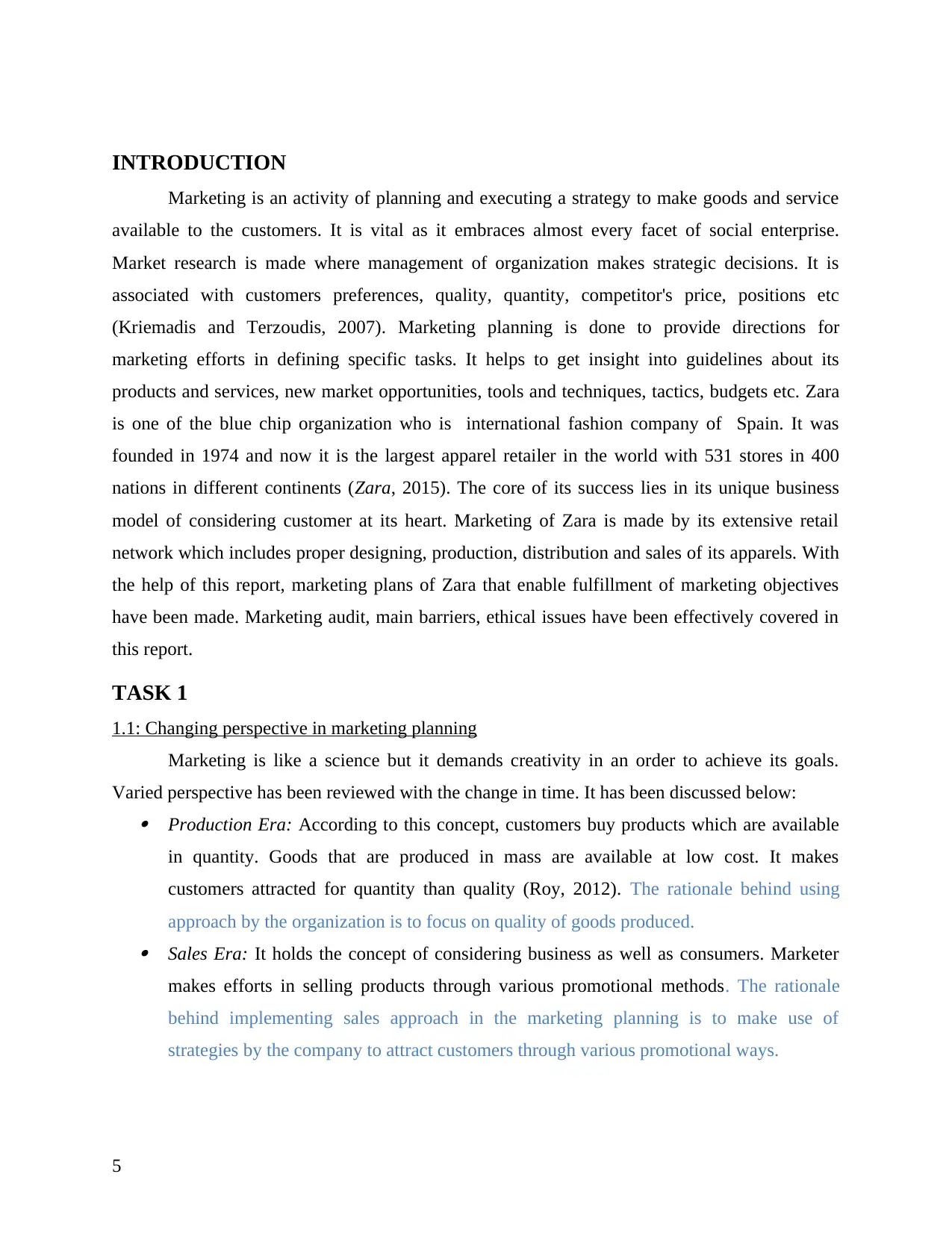
INTRODUCTION
Marketing is an activity of planning and executing a strategy to make goods and service
available to the customers. It is vital as it embraces almost every facet of social enterprise.
Market research is made where management of organization makes strategic decisions. It is
associated with customers preferences, quality, quantity, competitor's price, positions etc
(Kriemadis and Terzoudis, 2007). Marketing planning is done to provide directions for
marketing efforts in defining specific tasks. It helps to get insight into guidelines about its
products and services, new market opportunities, tools and techniques, tactics, budgets etc. Zara
is one of the blue chip organization who is international fashion company of Spain. It was
founded in 1974 and now it is the largest apparel retailer in the world with 531 stores in 400
nations in different continents (Zara, 2015). The core of its success lies in its unique business
model of considering customer at its heart. Marketing of Zara is made by its extensive retail
network which includes proper designing, production, distribution and sales of its apparels. With
the help of this report, marketing plans of Zara that enable fulfillment of marketing objectives
have been made. Marketing audit, main barriers, ethical issues have been effectively covered in
this report.
TASK 1
1.1: Changing perspective in marketing planning
Marketing is like a science but it demands creativity in an order to achieve its goals.
Varied perspective has been reviewed with the change in time. It has been discussed below: Production Era: According to this concept, customers buy products which are available
in quantity. Goods that are produced in mass are available at low cost. It makes
customers attracted for quantity than quality (Roy, 2012). The rationale behind using
approach by the organization is to focus on quality of goods produced. Sales Era: It holds the concept of considering business as well as consumers. Marketer
makes efforts in selling products through various promotional methods. The rationale
behind implementing sales approach in the marketing planning is to make use of
strategies by the company to attract customers through various promotional ways.
5
Marketing is an activity of planning and executing a strategy to make goods and service
available to the customers. It is vital as it embraces almost every facet of social enterprise.
Market research is made where management of organization makes strategic decisions. It is
associated with customers preferences, quality, quantity, competitor's price, positions etc
(Kriemadis and Terzoudis, 2007). Marketing planning is done to provide directions for
marketing efforts in defining specific tasks. It helps to get insight into guidelines about its
products and services, new market opportunities, tools and techniques, tactics, budgets etc. Zara
is one of the blue chip organization who is international fashion company of Spain. It was
founded in 1974 and now it is the largest apparel retailer in the world with 531 stores in 400
nations in different continents (Zara, 2015). The core of its success lies in its unique business
model of considering customer at its heart. Marketing of Zara is made by its extensive retail
network which includes proper designing, production, distribution and sales of its apparels. With
the help of this report, marketing plans of Zara that enable fulfillment of marketing objectives
have been made. Marketing audit, main barriers, ethical issues have been effectively covered in
this report.
TASK 1
1.1: Changing perspective in marketing planning
Marketing is like a science but it demands creativity in an order to achieve its goals.
Varied perspective has been reviewed with the change in time. It has been discussed below: Production Era: According to this concept, customers buy products which are available
in quantity. Goods that are produced in mass are available at low cost. It makes
customers attracted for quantity than quality (Roy, 2012). The rationale behind using
approach by the organization is to focus on quality of goods produced. Sales Era: It holds the concept of considering business as well as consumers. Marketer
makes efforts in selling products through various promotional methods. The rationale
behind implementing sales approach in the marketing planning is to make use of
strategies by the company to attract customers through various promotional ways.
5
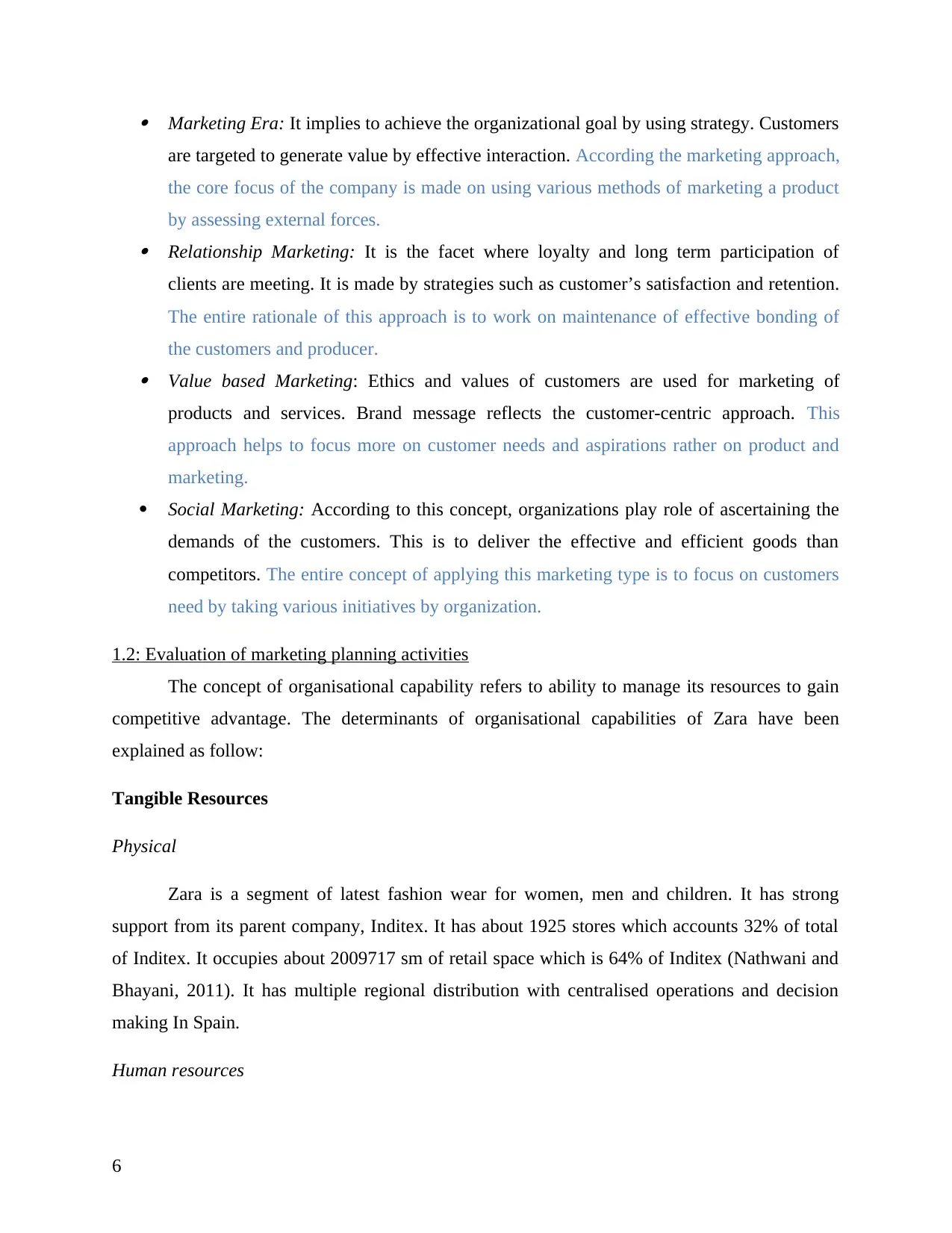
Marketing Era: It implies to achieve the organizational goal by using strategy. Customers
are targeted to generate value by effective interaction. According the marketing approach,
the core focus of the company is made on using various methods of marketing a product
by assessing external forces. Relationship Marketing: It is the facet where loyalty and long term participation of
clients are meeting. It is made by strategies such as customer’s satisfaction and retention.
The entire rationale of this approach is to work on maintenance of effective bonding of
the customers and producer. Value based Marketing: Ethics and values of customers are used for marketing of
products and services. Brand message reflects the customer-centric approach. This
approach helps to focus more on customer needs and aspirations rather on product and
marketing.
Social Marketing: According to this concept, organizations play role of ascertaining the
demands of the customers. This is to deliver the effective and efficient goods than
competitors. The entire concept of applying this marketing type is to focus on customers
need by taking various initiatives by organization.
1.2: Evaluation of marketing planning activities
The concept of organisational capability refers to ability to manage its resources to gain
competitive advantage. The determinants of organisational capabilities of Zara have been
explained as follow:
Tangible Resources
Physical
Zara is a segment of latest fashion wear for women, men and children. It has strong
support from its parent company, Inditex. It has about 1925 stores which accounts 32% of total
of Inditex. It occupies about 2009717 sm of retail space which is 64% of Inditex (Nathwani and
Bhayani, 2011). It has multiple regional distribution with centralised operations and decision
making In Spain.
Human resources
6
are targeted to generate value by effective interaction. According the marketing approach,
the core focus of the company is made on using various methods of marketing a product
by assessing external forces. Relationship Marketing: It is the facet where loyalty and long term participation of
clients are meeting. It is made by strategies such as customer’s satisfaction and retention.
The entire rationale of this approach is to work on maintenance of effective bonding of
the customers and producer. Value based Marketing: Ethics and values of customers are used for marketing of
products and services. Brand message reflects the customer-centric approach. This
approach helps to focus more on customer needs and aspirations rather on product and
marketing.
Social Marketing: According to this concept, organizations play role of ascertaining the
demands of the customers. This is to deliver the effective and efficient goods than
competitors. The entire concept of applying this marketing type is to focus on customers
need by taking various initiatives by organization.
1.2: Evaluation of marketing planning activities
The concept of organisational capability refers to ability to manage its resources to gain
competitive advantage. The determinants of organisational capabilities of Zara have been
explained as follow:
Tangible Resources
Physical
Zara is a segment of latest fashion wear for women, men and children. It has strong
support from its parent company, Inditex. It has about 1925 stores which accounts 32% of total
of Inditex. It occupies about 2009717 sm of retail space which is 64% of Inditex (Nathwani and
Bhayani, 2011). It has multiple regional distribution with centralised operations and decision
making In Spain.
Human resources
6
⊘ This is a preview!⊘
Do you want full access?
Subscribe today to unlock all pages.

Trusted by 1+ million students worldwide
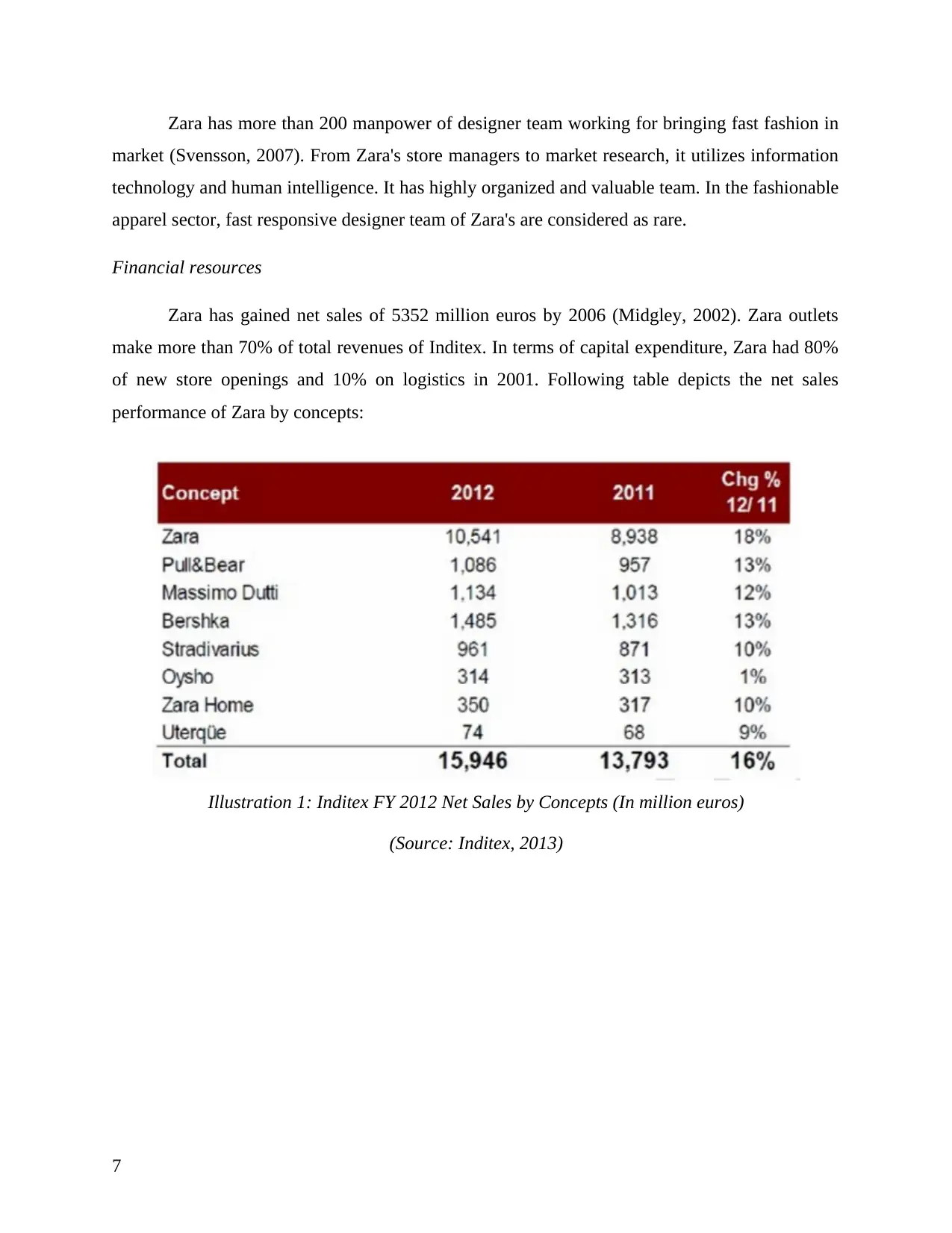
Zara has more than 200 manpower of designer team working for bringing fast fashion in
market (Svensson, 2007). From Zara's store managers to market research, it utilizes information
technology and human intelligence. It has highly organized and valuable team. In the fashionable
apparel sector, fast responsive designer team of Zara's are considered as rare.
Financial resources
Zara has gained net sales of 5352 million euros by 2006 (Midgley, 2002). Zara outlets
make more than 70% of total revenues of Inditex. In terms of capital expenditure, Zara had 80%
of new store openings and 10% on logistics in 2001. Following table depicts the net sales
performance of Zara by concepts:
7
Illustration 1: Inditex FY 2012 Net Sales by Concepts (In million euros)
(Source: Inditex, 2013)
market (Svensson, 2007). From Zara's store managers to market research, it utilizes information
technology and human intelligence. It has highly organized and valuable team. In the fashionable
apparel sector, fast responsive designer team of Zara's are considered as rare.
Financial resources
Zara has gained net sales of 5352 million euros by 2006 (Midgley, 2002). Zara outlets
make more than 70% of total revenues of Inditex. In terms of capital expenditure, Zara had 80%
of new store openings and 10% on logistics in 2001. Following table depicts the net sales
performance of Zara by concepts:
7
Illustration 1: Inditex FY 2012 Net Sales by Concepts (In million euros)
(Source: Inditex, 2013)
Paraphrase This Document
Need a fresh take? Get an instant paraphrase of this document with our AI Paraphraser
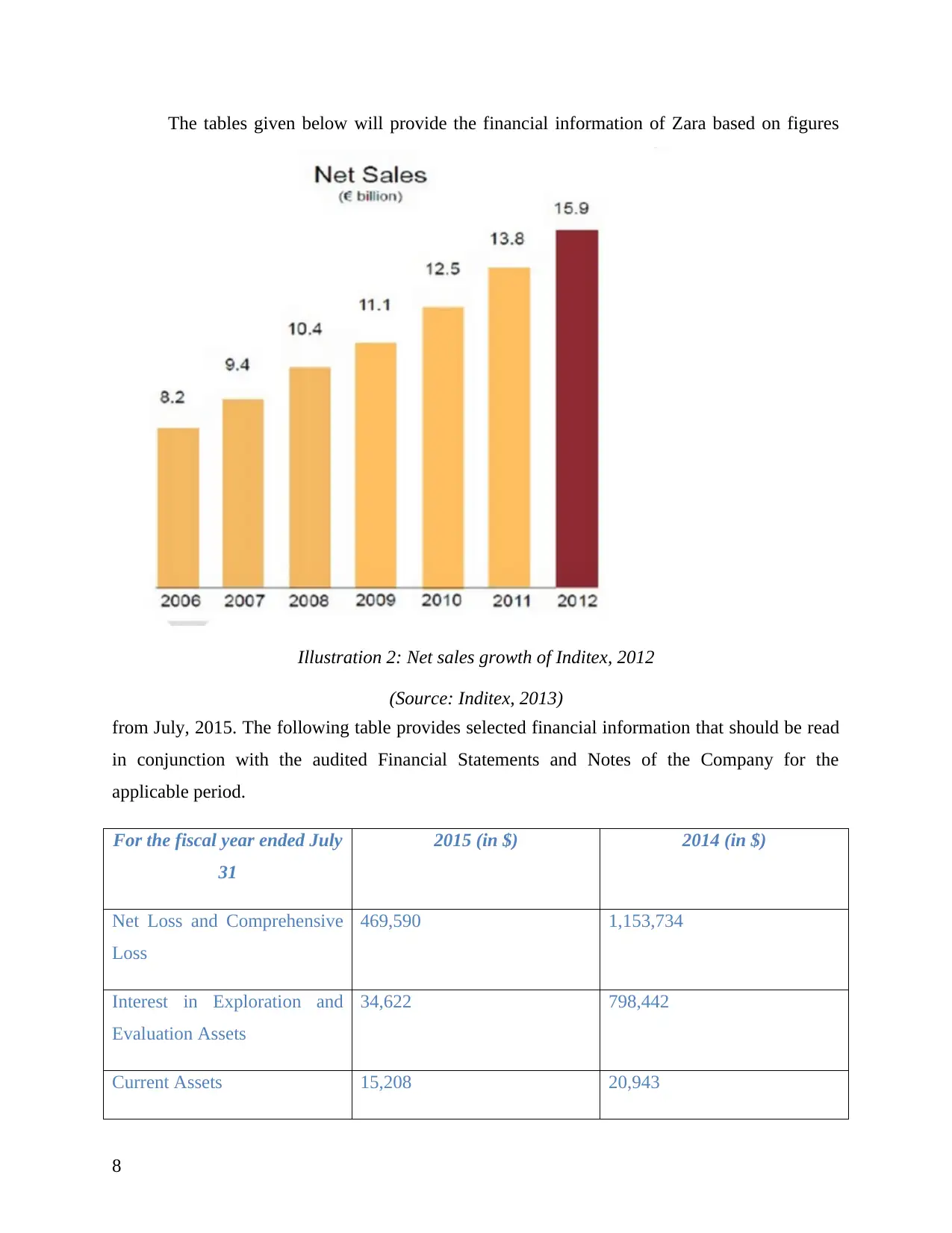
The tables given below will provide the financial information of Zara based on figures
from July, 2015. The following table provides selected financial information that should be read
in conjunction with the audited Financial Statements and Notes of the Company for the
applicable period.
For the fiscal year ended July
31
2015 (in $) 2014 (in $)
Net Loss and Comprehensive
Loss
469,590 1,153,734
Interest in Exploration and
Evaluation Assets
34,622 798,442
Current Assets 15,208 20,943
8
Illustration 2: Net sales growth of Inditex, 2012
(Source: Inditex, 2013)
from July, 2015. The following table provides selected financial information that should be read
in conjunction with the audited Financial Statements and Notes of the Company for the
applicable period.
For the fiscal year ended July
31
2015 (in $) 2014 (in $)
Net Loss and Comprehensive
Loss
469,590 1,153,734
Interest in Exploration and
Evaluation Assets
34,622 798,442
Current Assets 15,208 20,943
8
Illustration 2: Net sales growth of Inditex, 2012
(Source: Inditex, 2013)
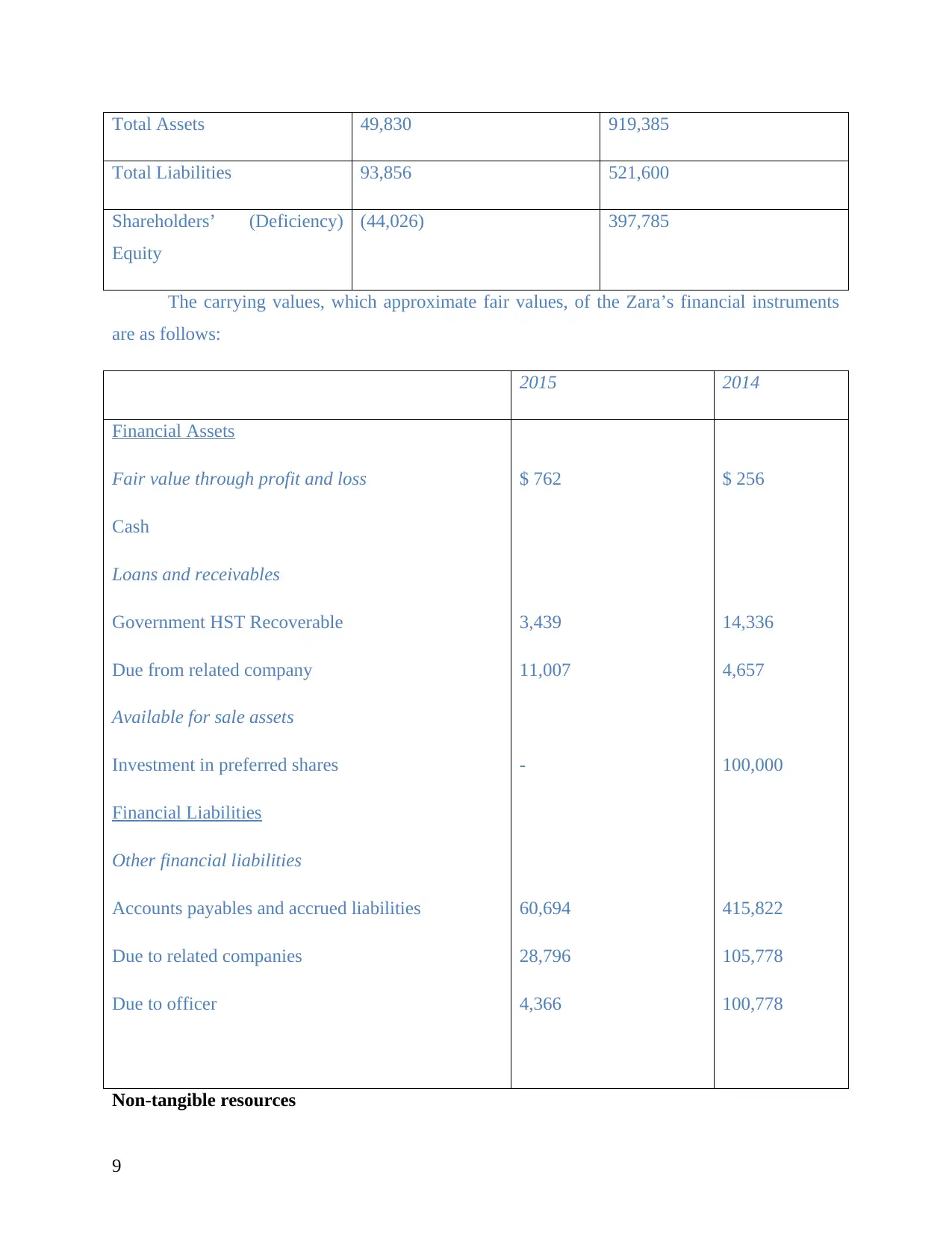
Total Assets 49,830 919,385
Total Liabilities 93,856 521,600
Shareholders’ (Deficiency)
Equity
(44,026) 397,785
The carrying values, which approximate fair values, of the Zara’s financial instruments
are as follows:
2015 2014
Financial Assets
Fair value through profit and loss
Cash
Loans and receivables
Government HST Recoverable
Due from related company
Available for sale assets
Investment in preferred shares
Financial Liabilities
Other financial liabilities
Accounts payables and accrued liabilities
Due to related companies
Due to officer
$ 762
3,439
11,007
-
60,694
28,796
4,366
$ 256
14,336
4,657
100,000
415,822
105,778
100,778
Non-tangible resources
9
Total Liabilities 93,856 521,600
Shareholders’ (Deficiency)
Equity
(44,026) 397,785
The carrying values, which approximate fair values, of the Zara’s financial instruments
are as follows:
2015 2014
Financial Assets
Fair value through profit and loss
Cash
Loans and receivables
Government HST Recoverable
Due from related company
Available for sale assets
Investment in preferred shares
Financial Liabilities
Other financial liabilities
Accounts payables and accrued liabilities
Due to related companies
Due to officer
$ 762
3,439
11,007
-
60,694
28,796
4,366
$ 256
14,336
4,657
100,000
415,822
105,778
100,778
Non-tangible resources
9
⊘ This is a preview!⊘
Do you want full access?
Subscribe today to unlock all pages.

Trusted by 1+ million students worldwide
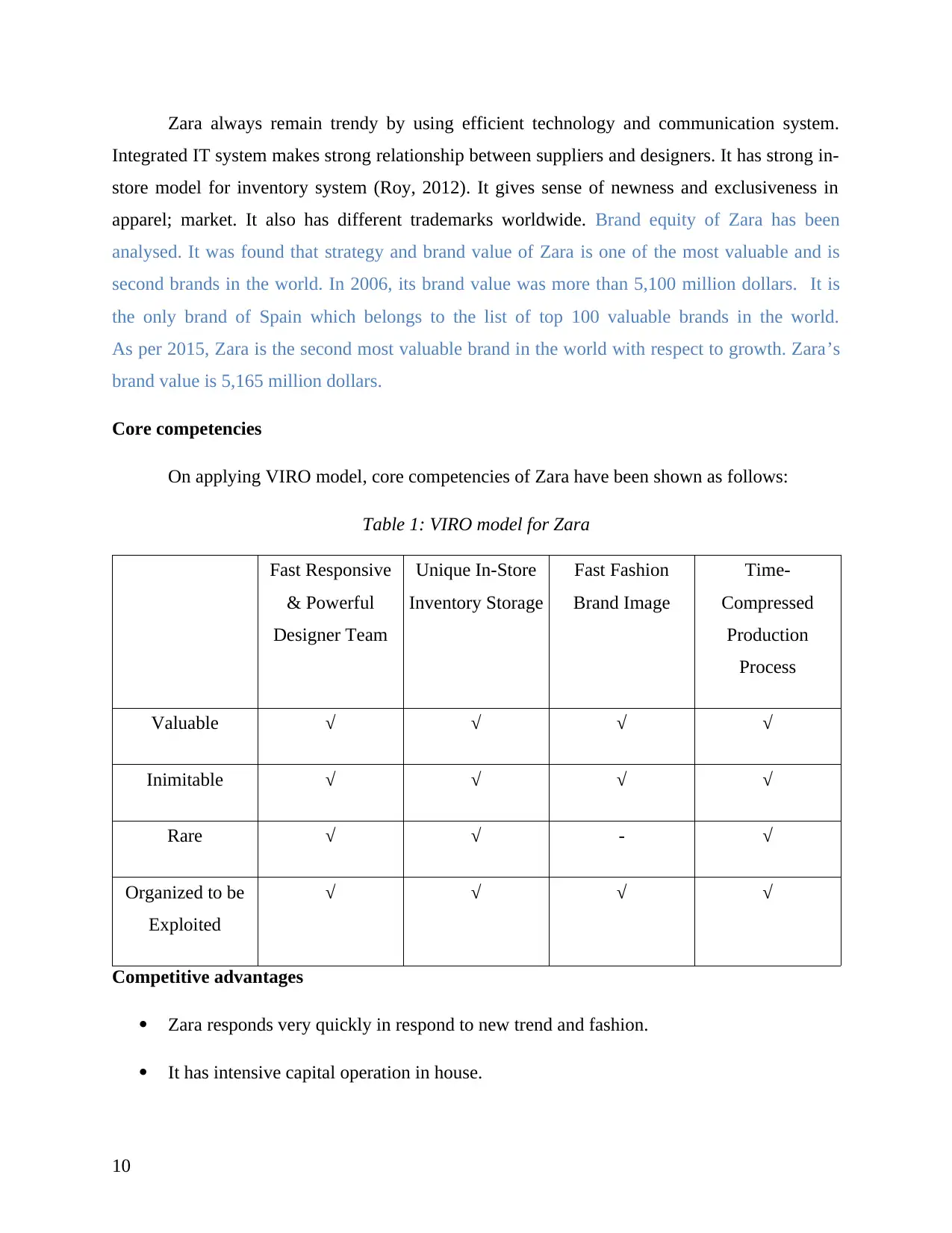
Zara always remain trendy by using efficient technology and communication system.
Integrated IT system makes strong relationship between suppliers and designers. It has strong in-
store model for inventory system (Roy, 2012). It gives sense of newness and exclusiveness in
apparel; market. It also has different trademarks worldwide. Brand equity of Zara has been
analysed. It was found that strategy and brand value of Zara is one of the most valuable and is
second brands in the world. In 2006, its brand value was more than 5,100 million dollars. It is
the only brand of Spain which belongs to the list of top 100 valuable brands in the world.
As per 2015, Zara is the second most valuable brand in the world with respect to growth. Zara’s
brand value is 5,165 million dollars.
Core competencies
On applying VIRO model, core competencies of Zara have been shown as follows:
Table 1: VIRO model for Zara
Fast Responsive
& Powerful
Designer Team
Unique In-Store
Inventory Storage
Fast Fashion
Brand Image
Time-
Compressed
Production
Process
Valuable √ √ √ √
Inimitable √ √ √ √
Rare √ √ - √
Organized to be
Exploited
√ √ √ √
Competitive advantages
Zara responds very quickly in respond to new trend and fashion.
It has intensive capital operation in house.
10
Integrated IT system makes strong relationship between suppliers and designers. It has strong in-
store model for inventory system (Roy, 2012). It gives sense of newness and exclusiveness in
apparel; market. It also has different trademarks worldwide. Brand equity of Zara has been
analysed. It was found that strategy and brand value of Zara is one of the most valuable and is
second brands in the world. In 2006, its brand value was more than 5,100 million dollars. It is
the only brand of Spain which belongs to the list of top 100 valuable brands in the world.
As per 2015, Zara is the second most valuable brand in the world with respect to growth. Zara’s
brand value is 5,165 million dollars.
Core competencies
On applying VIRO model, core competencies of Zara have been shown as follows:
Table 1: VIRO model for Zara
Fast Responsive
& Powerful
Designer Team
Unique In-Store
Inventory Storage
Fast Fashion
Brand Image
Time-
Compressed
Production
Process
Valuable √ √ √ √
Inimitable √ √ √ √
Rare √ √ - √
Organized to be
Exploited
√ √ √ √
Competitive advantages
Zara responds very quickly in respond to new trend and fashion.
It has intensive capital operation in house.
10
Paraphrase This Document
Need a fresh take? Get an instant paraphrase of this document with our AI Paraphraser
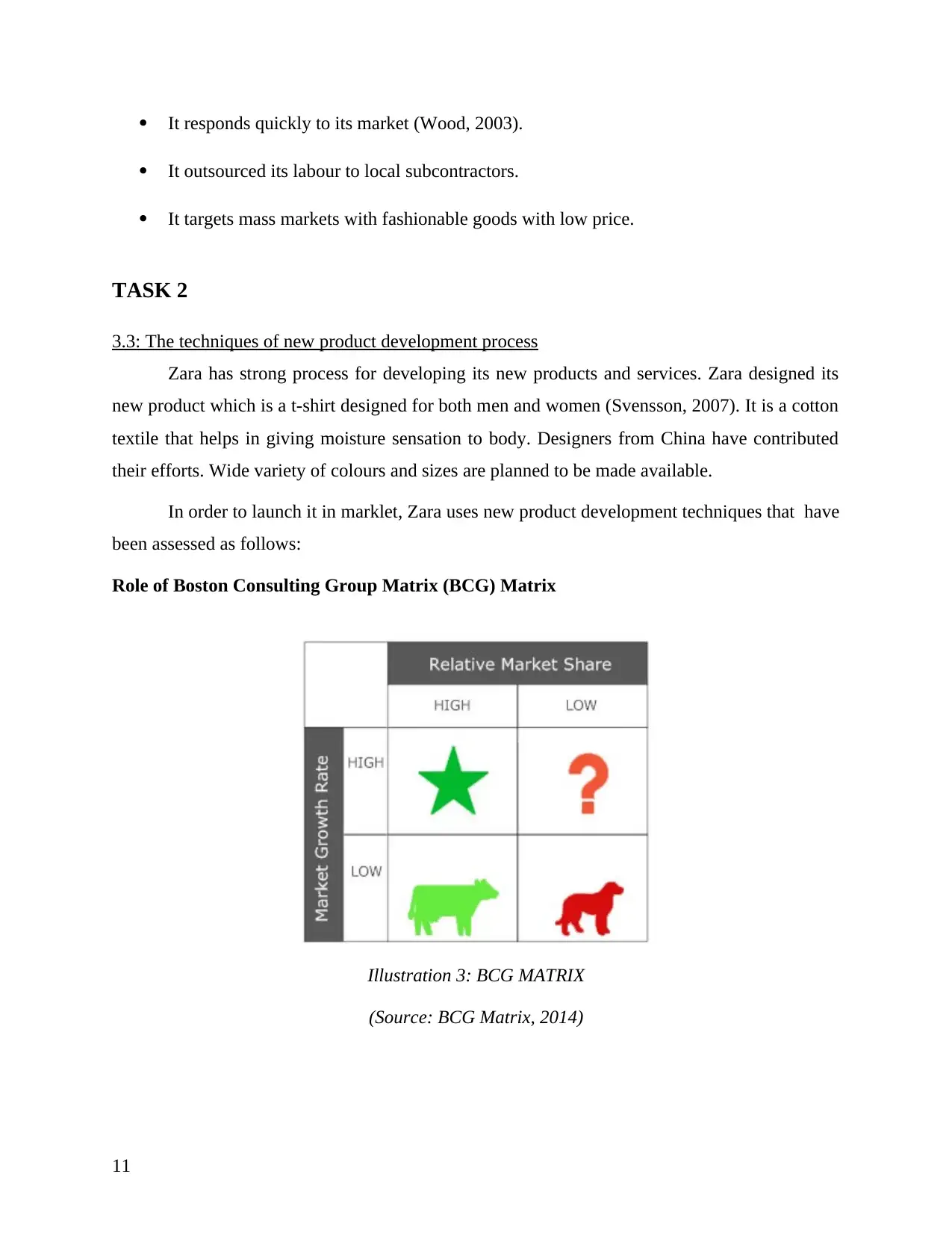
It responds quickly to its market (Wood, 2003).
It outsourced its labour to local subcontractors.
It targets mass markets with fashionable goods with low price.
TASK 2
3.3: The techniques of new product development process
Zara has strong process for developing its new products and services. Zara designed its
new product which is a t-shirt designed for both men and women (Svensson, 2007). It is a cotton
textile that helps in giving moisture sensation to body. Designers from China have contributed
their efforts. Wide variety of colours and sizes are planned to be made available.
In order to launch it in marklet, Zara uses new product development techniques that have
been assessed as follows:
Role of Boston Consulting Group Matrix (BCG) Matrix
11
Illustration 3: BCG MATRIX
(Source: BCG Matrix, 2014)
It outsourced its labour to local subcontractors.
It targets mass markets with fashionable goods with low price.
TASK 2
3.3: The techniques of new product development process
Zara has strong process for developing its new products and services. Zara designed its
new product which is a t-shirt designed for both men and women (Svensson, 2007). It is a cotton
textile that helps in giving moisture sensation to body. Designers from China have contributed
their efforts. Wide variety of colours and sizes are planned to be made available.
In order to launch it in marklet, Zara uses new product development techniques that have
been assessed as follows:
Role of Boston Consulting Group Matrix (BCG) Matrix
11
Illustration 3: BCG MATRIX
(Source: BCG Matrix, 2014)
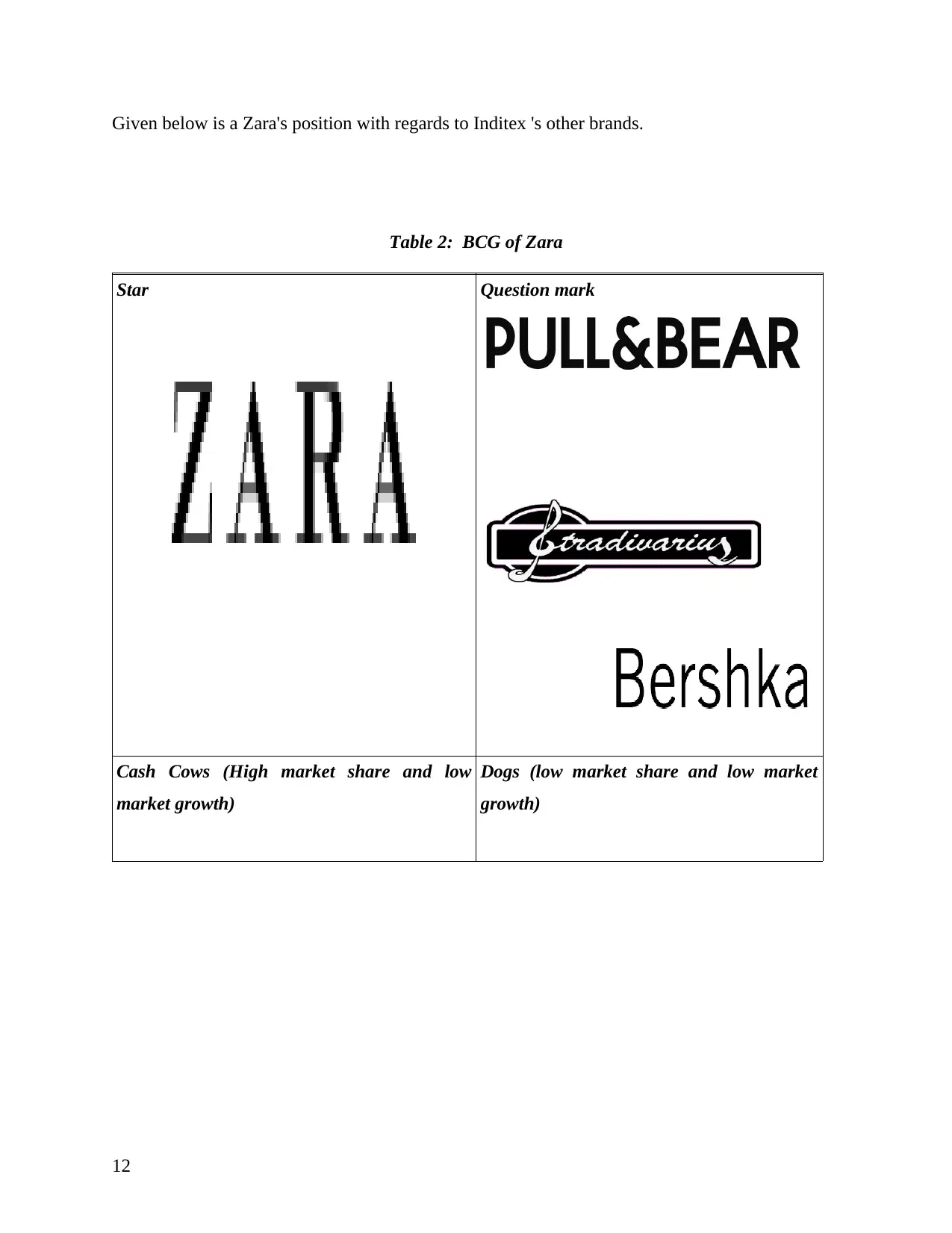
Given below is a Zara's position with regards to Inditex 's other brands.
Table 2: BCG of Zara
Star Question mark
Cash Cows (High market share and low
market growth)
Dogs (low market share and low market
growth)
12
Table 2: BCG of Zara
Star Question mark
Cash Cows (High market share and low
market growth)
Dogs (low market share and low market
growth)
12
⊘ This is a preview!⊘
Do you want full access?
Subscribe today to unlock all pages.

Trusted by 1+ million students worldwide
1 out of 28
Related Documents
Your All-in-One AI-Powered Toolkit for Academic Success.
+13062052269
info@desklib.com
Available 24*7 on WhatsApp / Email
![[object Object]](/_next/static/media/star-bottom.7253800d.svg)
Unlock your academic potential
Copyright © 2020–2025 A2Z Services. All Rights Reserved. Developed and managed by ZUCOL.





